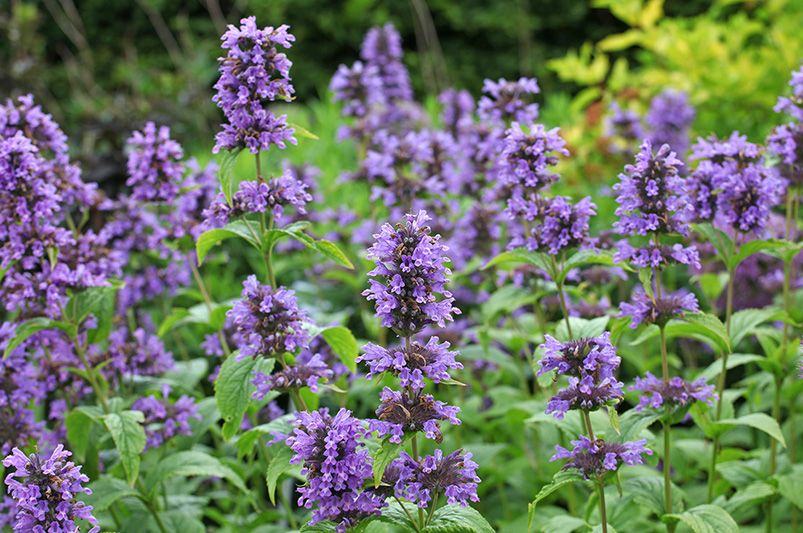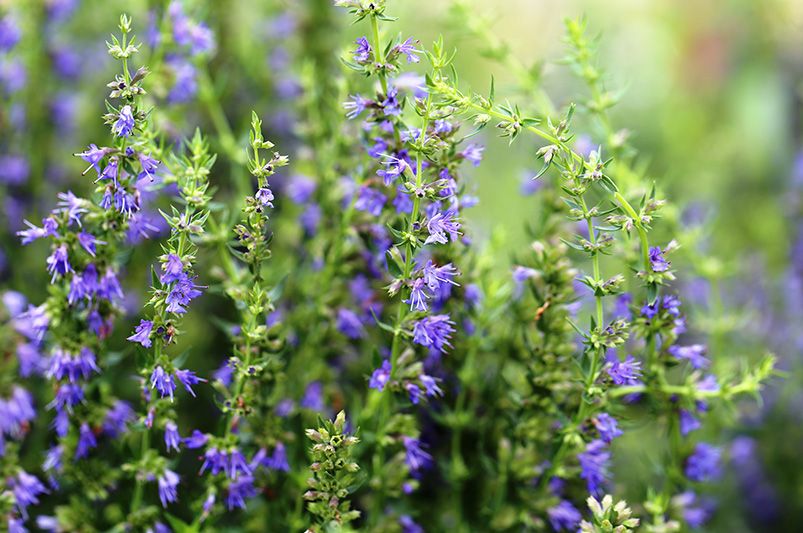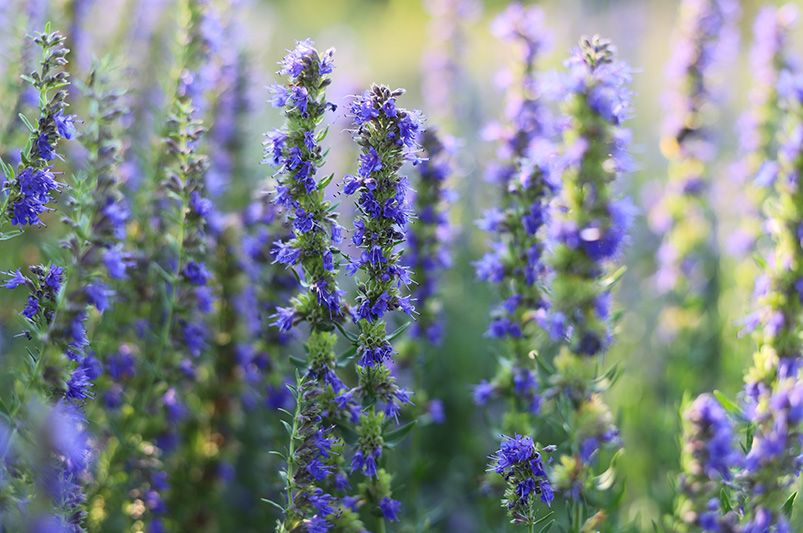
Purple Haze Hyssop: A Gardener's Guide
Published: 19/07/2024 | Updated: 19/07/2024
Get ready to dive into the vibrant world of Purple Haze Hyssop! Hyssop (Hyssopus officinalis) is a flowering, semi-evergreen plant with pungent leaves and a mint or sage-like smell. It is native to Europe, Asia, and Africa. This stunning plant isn't just a feast for the eyes with its beautiful purple blooms; it's also a magnet for bees and butterflies, adding life and energy to your garden. In this guide, we'll share everything you need to know to grow and care for Purple Haze Hyssop, making it easier than ever to add a pop of color and a touch of wildlife to your outdoor space. Whether you're a seasoned gardener or just starting, you're in for a treat as we explore the secrets to nurturing this delightful plant. Let's get our hands dirty and transform your garden into a blooming paradise that buzzes with beauty!


Get To Know The Purple Haze Hyssop
Classic Purple Haze Hyssop
The Classic Purple Haze Hyssop is the star of the show, known for its deep violet blooms that can make any garden pop. This variety is a real head-turner, with flower clusters around the stem like little purple fireworks. It thrives in full sun and well-drained soil, and once established, it's wonderfully drought-resistant. Give it some love in the early days, and you'll have a resilient, eye-catching plant that's as low-maintenance as beautiful.
Best Environment for Growth
All varieties of Purple Haze Hyssop share a love for the sunshine and well-draining soil. They're adaptable plants but perform best when basking in at least six hours of direct sunlight daily. They're cold-hardy, making them an excellent choice for gardeners in cooler climates and those enjoying warmer weather.
When it comes to care, these plants are relatively low-fuss. Just ensure they're planted in the right spot, keep an eye on watering needs during their first season, and you'll be rewarded with a vibrant, lively garden space. Remember, the key to a thriving hyssop garden is a happy medium between care and letting nature do its thing.
So, whether you're drawn to the classic beauty of the Classic Purple Haze, the soft allure of Lavender Mist, or the enchanting depth of Twilight Magic, a hyssop variety is perfect for your garden. Let's embrace these mesmerizing plants and bring a touch of magic to our outdoor spaces!

Plantation and Growth: Your Path to Purple Haze Success
Ready to bring some Purple Haze Hyssop magic into your garden? Planting and nurturing these vibrant beauties is straightforward and rewarding. Let's walk through the steps to ensure your hyssops flourish:
Choosing the Right Time: Timing is everything! The best time to plant Purple Haze Hyssop is in the spring after the threat of frost has passed. This gives your plants ample time to establish themselves during the warmer months. If you live in a milder climate, fall planting is also an option, allowing the roots to develop before the summer heat.
Planting Like a Pro: Pick Your Spot: Hyssops love sunlight, so choose a location where they'll get at least six hours of direct sun each day. Ensure the area has well-draining soil to prevent water from pooling around the roots.
Soil Prep: Loosen the soil and mix in some compost or aged manure to give your plants a nutritious start. Consider raising the beds or mixing in some sand to improve drainage if your soil is heavy or clay-like.
Planting:
- Dig a hole deep enough for the root ball and twice as wide.
- Gently remove the plant from its container, loosen the roots, and place it in the hole.
- Fill in with soil, pressing down gently to eliminate air pockets and water thoroughly.
Caring for Your Plants:
Once your Purple Haze Hyssops are in the ground, they don't ask for much—just a bit of care and attention to help them along:
Watering: Hyssops are relatively drought-tolerant, but they'll need regular watering during their first growing season to help them settle in. Once established, you can cut back, watering only during extended dry periods.
Mulching: Apply a layer of organic mulch around the plants to help retain moisture, suppress weeds, and keep the roots cool. Just be sure not to pile it up against the stems to avoid moisture-related problems.
Feeding: Feed your plants in early spring with a balanced, slow-release fertilizer to support robust growth and blooming. Too much fertilizer can encourage more leaves at the expense of flowers, so a little goes a long way.
Pruning: In late fall or early spring, prune back the spent flowers and any dead or damaged stems to keep your hyssops tidy and healthy. This also encourages more blooms the following season. We'll discuss this in more detail in the section.
Watching Them Grow
Sit back and watch your Purple Haze Hyssop plants take off. With just these simple steps, you'll see them grow into vibrant, blooming beauties that brighten up your garden and attract pollinators like bees and butterflies. It's a win-win for everyone!
So, grab your gardening gloves and get ready to transform your garden with some Purple Haze charm. Happy planting!
Pruning & Propagation: Keeping Your Hyssops Happy and Healthy
Ever wonder how to keep your Purple Haze Hyssop looking fabulous and encourage even more of these stunners in your garden? The secrets are simple: pruning and propagation. Let's explore how to master these techniques easily and with some fun.
Pruning: No Fuss!
Pruning isn't just about playing hairdressers with your plants but about helping them grow enthusiastically. For your Purple Haze Hyssop, regular pruning means bountiful blooms and a bush that's the envy of the neighborhood.
Here's the scoop on snipping:
When to Prune: Early spring is the ideal time for a trim. You can also deadhead (remove spent blooms) during the growing season to encourage more flowers.
How to Prune: Snip off the top third of your hyssop stems. This simple haircut encourages branching, which translates to more flowers. Just remember to use clean, sharp shears for a clean cut.
The Pruning Perk: In addition to promoting more blooms, pruning helps airflow through the plant, reducing the risk of disease. Think of it as your hyssop's personal health plan.
Propagation: More Hyssop? Yes, Please!
Want more of these purple pals without a trip to the nursery? Propagation is your DIY solution. And guess what? It's easier than trying to fold a fitted sheet.
Follow these steps to propagate like a pro:
Cutting Time: Cut 4-6 inch stem sections just below a leaf node in late spring or early summer. Nodes are like plant elbows, and that's where new roots will sprout.
Prep Your Cuttings: Remove the leaves from the lower half of the cutting. If you've got rooting hormone, dip the cut end into it; this isn't a must, but it's like giving your cuttings a growth-boosting vitamin.
Plant Your Cuttings: Stick the cut end into a pot filled with sand and peat or a well-draining potting mix. Water it, cover the pot with a plastic bag to create a mini greenhouse, and place it in indirect light.
Wait for the Magic: Keep the soil moist, and after a few weeks, give a gentle tug. Resistance means roots are forming. Once they're robust, transfer your new hyssop babies to the garden.
By following these handy tips, you will keep your Purple Haze Hyssop plants healthy and vibrant and have a bunch of new ones to spread around your garden or share with friends. Pruning and propagation may become your favorite gardening activities (after admiring your garden's beauty, of course!)

Common Pests & Diseases: Taking Care of Your Hyssops
Imagine throwing a garden party and only inviting the guests you like. In a perfect world, right? Unfortunately, when it comes to gardening, especially with our beloved Purple Haze Hyssop, some uninvited guests—namely pests and diseases—might crash the party. But don't worry. We've got the lowdown on how to show them the door gently and effectively.
The Usual Suspects
Aphids: These little critters are like the gate-crashers who head straight for the buffet. They love to suck on the plant sap, weakening your hyssops. But here's a trick - a blast of water from the hose or an application of soapy water usually sends them packing.
Spider Mites: These tiny pests throw their garden party with silk streamers (webs) and munch on your plants. The solution? The same as aphids—water blast or soapy water. For an added kick, neem oil can also be a party-pooper for them.
Powdery Mildew: This one's a bit like having fog at your garden party – it covers leaves with a whitish, powdery coat. It usually shows up when the leaves stay damp, and airflow is more like a 'no flow.' Keep your plants well-spaced and prune them for good air circulation to keep this mildew at bay.
Prevention: The Best Medicine
The best strategy is all about prevention. Monitor your plants, give them space to breathe, and ensure they're not too thirsty or drowning in water. Healthy plants are like happy party hosts—less likely to let pests and diseases crash their vibe.
In Case of Crashers
If pests or diseases do show up, handle them with care. Opt for gentle, natural remedies first. Sometimes, all it takes is removing or treating affected parts with organic options like neem oil or insecticidal soap. Think of it as kindly showing the gate-crashers out without causing a scene.
Remember, a little vigilance goes a long way in keeping your Purple Haze Hyssop healthy, vibrant, and flourishing. It's all about creating a memorable garden party for the right reasons – stunning flowers, happy pollinators, and one very pleased gardener. So, here's to fewer pests and diseases and more blooming good times!
Wrapping It Up: Your Thriving Purple Haze Hyssop Garden
Congratulations on taking this deep dive into the world of Purple Haze Hyssop! Equipped with tips on regular care, beating pests, propagation, and pruning, you're ready to transform your garden into a spectacular showcase of these vibrant purple wonders.
Whether you're a seasoned gardener or just starting your green thumb journey, remember that gardening is a continuous learning process. Each plant has its personality, and the Purple Haze Hyssop is no exception. Embrace the moments spent in your garden, from the victorious blooms to the occasional challenges.
Each season, you'll find that your skills improve, your garden flourishes and your love for gardening grows. So, plant your hyssops, care for them, and watch as they bring a stunning burst of purple to your outdoor space. Happy gardening, and here's to your beautiful Purple Haze Hyssop blossoms brightening many days ahead!


